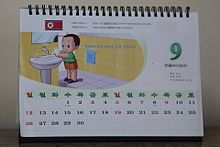|
Juche calendar
The Juche calendar, named after the Juche ideology, was the system of year-numbering used in North Korea. It begins with the birth of Kim Il Sung, the founder of North Korea. His birth year, 1912 in the Gregorian calendar, is "Juche 1" in the Juche calendar. The calendar was adopted in 1997, three years after the death of Kim Il Sung. HistoryThe calendar borrows elements from two historical calendars used in Korea, the traditional system of Korean era names and the Gregorian calendar in which years are tied to the traditional birth of Jesus. In contrast to these two, the Juche calendar begins with the birth of the founder of the Democratic People's Republic, Kim Il Sung.[1] The decree on the Juche calendar was adopted on 8 July 1997, on the third anniversary of the death of Kim Il Sung. The same decree also designated the birth anniversary of Kim Il Sung as the Day of the Sun. The birth year of Kim Il Sung, 1912 in the Gregorian calendar, became "Juche 1" in the Juche calendar.[2][3] The calendar began to be implemented on 9 September 1997, the Day of the Foundation of the Republic.[2] On that date, newspapers, news agencies, radio stations, public transport, and birth certificates began to use Juche years.[4] The Gregorian calendar was used alongside the Juche calendar until 2022.[5] In October 2024, North Korea started to stop using the Juche calendar. On 13 October 2024, Rodong Sinmun stopped using the calendar in favour of solely using the Gregorian calendar.[6][7] UsageThe year 1912 is "Juche 1" in the Juche calendar. There are no "before Juche" years; years before 1912 are given numbers based on the Gregorian calendar only. Ranges of years that begin before 1912 and end after it are also given in Christian calendar numbers only.[8] Any other years after 1912 will be given in either Juche years only, or in Juche years and the corresponding year in the Christian calendar in parentheses. In material pertaining to relations with foreign countries, "the Juche Era and the Christian Era may be used on the principles of independence, equality and reciprocity."[8] The Juche calendar is a popular souvenir among tourists visiting North Korea.[9] Examples
See also
References
External links |
||||||||||||||||||||||||||||||||||||||||||||||||||||||||||||||||||||||||||||||||||||||||||||
